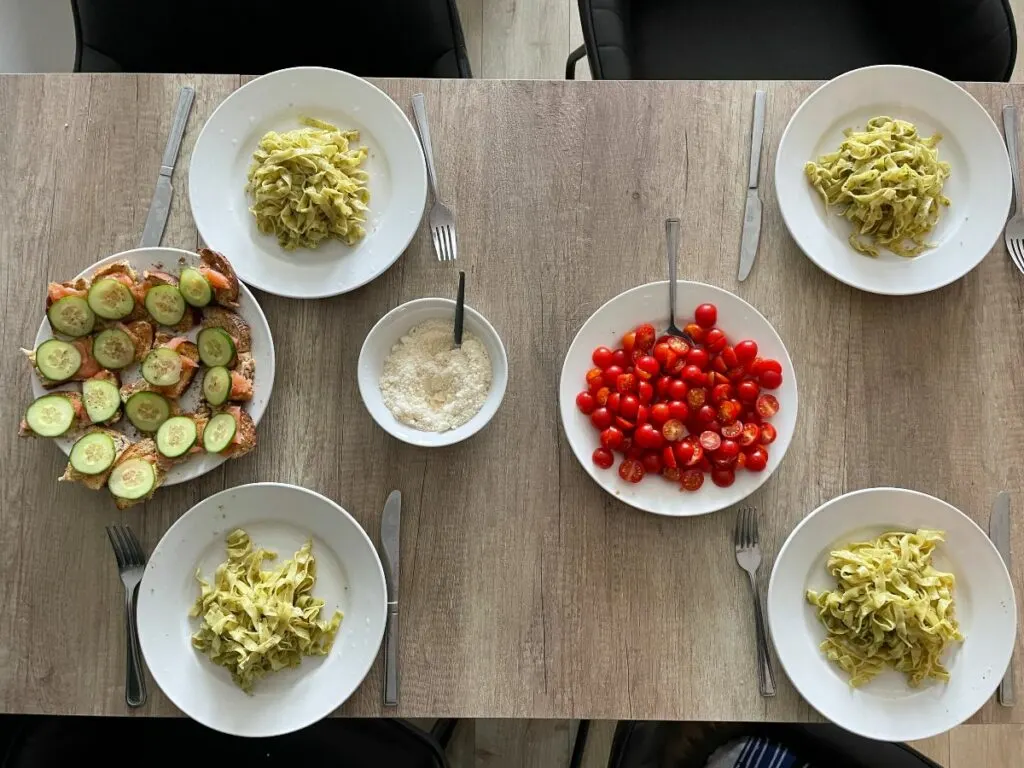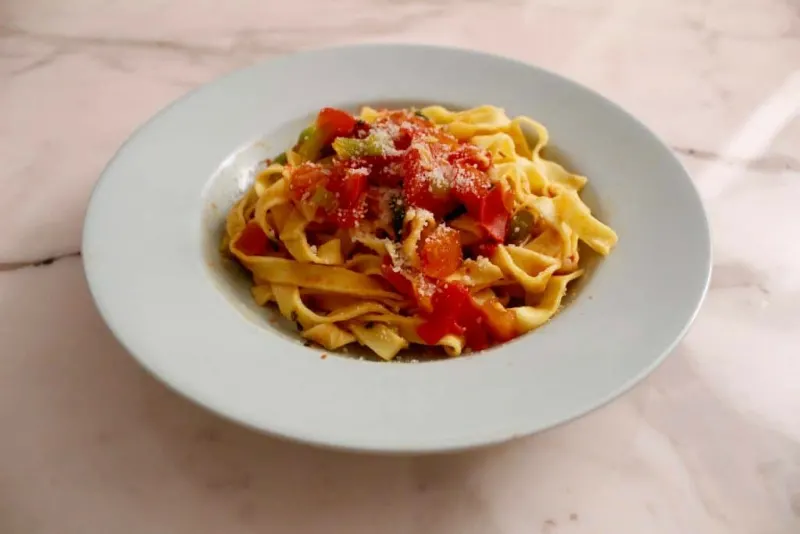Family vacations can be magical and packed with life-long memories, but they can also be incredibly expensive. From airfare to lodging to transportation to tickets for memorable experiences, the costs mount quickly. After years of family vacations under my belt, both with larger family groups, with friends, and with just our nuclear family, I can say that I am a true believer in the value of cooking while on vacation.

I know that cooking may be the last thing you want to think about while you’re on vacation, but I hope you will give me a chance to make my case for why preparing meals on vacation is worth it, especially as I share my tips and tricks for how to make it as easy, stress-free, and delicious as possible.
Before I highlight why cooking while on vacation is a good idea, I do want to make the point that this only works if you are staying in a house or apartment that has a kitchen. So, when you’re booking your lodgings, make sure to look at Air BnB, VRBO, or some other platform that offers places with kitchen you can actually cook in.

Why Cooking While on Vacation is a Good Idea
While I understand that one of the reasons we go on vacation is to get a break from the daily tasks of life, I have come to find that there are a number of benefits to preparing at least some of your meals while on vacation. Here are my top reasons why cooking on vacation is a good idea:
- You can save A LOT of money. Depending on how many meals you eat at home and how many you eat out (see suggestions on this below), you can easily save a couple of hundred dollars just by eating some quick and simple meals at your vacation rental.
- Family meals at the rental can provide time for respite and reconnection. Family vacations tend to be really busy – whether sight seeing or engaging in lots of outdoor fun, we often try to pack lots into our family trips. And while all of that busyness is really fun, having down time when you can recharge and just spend more relaxed time together is incredibly valuable (and will make the busy times much more fun).
- Home-cooked meals can help everyone’s bodies to stay on track. When we eat out a lot, the increase in unfamiliar (and often harder to digest, richer, more fried, etc.) foods, can often lead to digestive issues such as indigestion or less regular bowel movements. If you have some of your meals at home, it can be easier to include some of the foods that help to keep your family on track.

Meals at home and meals out
You want a trip away from home to feel relaxing and not like the daily grind that you left behind, so I recommend trying to come up with a system or balance of meals at home and meals out that will allow you to get the break you truly deserve, while also taking advantage of all of the benefits of cooking while on vacation described above.
There is no perfect balance of meals in and meals out. In fact, each time my family has gone on vacation we’ve done things a little differently. Here are the factors that my family has taken into account when we are planning out how often we will eat out and how often we will cooking for ourselves.
Breakfast
For my family, having breakfasts at the rental has always worked well. This is because we have some members of our family who bounce right out of bed and others who take quite a while to get going (especially now with teenagers in the house). By having breakfast at home we are able to let everyone reach their optimal energy level without a rush, which means the day starts off on the right foot.
Age of Your Kids
When our kids were younger, we found that by the end of a busy day of sight seeing or other adventures, our kids were exhausted. Their brains had taken in more than enough stimuli and what they really needed was some downtime. And, as we all know, overtired kids don’t often do so well in crowded restaurants where they have to wait for their food. Talk about stressful! So, in those younger years, we often would opt for cooking dinners at home (sometimes springing for a night or two out).
Now that our kids are teenagers, they are both developmentally better able to handle themselves in restaurants and have internal clocks that keep them up later. Plus, they’re more eager to experience the nightlife wherever we are visiting. So, dinners out have become a more common occurrence (although we still almost always do a mix).
Kitchen Set Up
Another giant factor in deciding how many and which sort of meals to do at your vacation rental will be what your kitchen set up and access to grocery stores looks like.
- Are there pots and pans that are big enough to feed your crew?
- Do you have access to other cooking and meal prep tools that you need (sharp knives, cutting boards, vegetable peeler, can opener, etc.)?
- Do you have a selection of seasonings that you can make use of or are you starting from a totally empty cupboard?
- Is there a grocery store near enough for easy trips?
Once you’ve assessed the situation, then you can start to figure out what meals are possible and what makes the most sense for your family.
If you’ve got a really well set up kitchen, then obviously preparing meals for your family will be easier. If, on the other hand, the kitchen is less than ideal, then focusing on breakfasts and lunches (especially lunches you can pack to bring with you) can be a good solution.
What meals out and meals in might look like
Here are how the meals during two big trips abroad worked for my family:
Trip 1: Traveling with younger kids
One one trip abroad, when our kids were 7 and 9 years old, my husband and I decided that we would try to eat most breakfasts and all dinners at home and all lunches out. For lunches, we did one meal at a family member’s house, two at restaurants, and the others were made up of street food enjoyed in parks where the boys could run around afterwards. For our breakfasts and dinners, we’d swing by a market each evening after our day of adventures to pick up whatever sounded good for dinner and for breakfast the next day, plus a bottle of wine (we were in France after all). We focused on meals that we could make quickly, easily, and with just a few fresh ingredients (no special spices or condiments) and that everyone would be open to eating.
Trip 2: Traveling with teens
On the other hand, when we recently traveled with teens, we shifted our approach. Each morning (while the teens slept), I would run down to the market to buy items for the morning’s breakfast as well as some lunch or snack options to bring with us during the day. We would have a large-ish breakfast in the late morning and then enjoy a combination of foods I brought supplemented by street food we came across mid-day. Then, towards the mid-to-late evening, we’d find a restaurant for dinner.

Keep it simple: ingredients
No matter which meals I am cooking, at the markets I always focus on getting small amounts of high-quality, fresh ingredients because I know that with good ingredients and simple preparation I can make delicious food without a lot of additional spices or flavor enhancers. I also buy smaller quantities so that we don’t have lots of leftover ingredients at the end of the week.
This means that I spring for some things that I normally wouldn’t at home. On trips in the past this has included: a cheese platter with a variety of cheeses for us to explore, a jar of paté, some high-end cured meats, some pre-prepared soup, pre-made pesto sauce, fresh pasta, and already grated Parmesan cheese. I also always make a point of getting fresh and local ingredients or specialty foods whenever possible so that we have an opportunity to try more local foods.

Keep it simple: meals
When I’m on vacation, I don’t want to spend a lot of time in the kitchen, so I stick to meals that require little to no prep, are ready in 20 minutes or less, and are things that I know how to make without a recipe.
Here are examples of what we have had for dinners:
- Pre-made soup with bread and cheese
- Appetizer nights with fresh bread, cheeses, pate, cured meats, and salad or raw vegetables
- Fresh pasta with a quick sauce made up of tomatoes, bell pepper, and leeks sautéed in a little bit of olive oil
- Fresh pasta with pre-made pesto sauce
- Omelets filled with sautéed leeks, diced tomatoes, and a little bit of cheese and a salad
Here’s what we have had for breakfasts:
- Baguettes or toast spread with butter and jam
- Fresh fruit
- Scrambled eggs
- Leftover bread and cheese from the night before
Here’s what we have had for lunches:
- Hummus and cucumber sandwiches
- Pre-made tuna salad in sandwiches
- Crackers and cheese
- Pre-packaged cookies from the country we’re visiting (exploring sweets is always fun)
- Fresh fruit that is in season

Relax on the rules
When we’re on vacation, we also relax our normal expectations for a balanced diet – more sugar, wine, and snack foods are enjoyed and dinners out, in particular, tend to be much richer than we normally eat. But we make sure to have fresh fruits and vegetables available at every meal we make at home.
An added bonus to being relaxed about the sugar and treats is that we have noticed on every trip that while my kids definitely gorge on sweets and sodas, they also seek out fresh vegetables and fruit, devouring salads at restaurants, vegetables in their sandwiches, and the fruit at breakfast.
In the end, keeping it simple, focusing on fresh ingredients, springing for some slightly more expensive specialty items, and making favorites I know everyone enjoys are all it takes for us to have a successful, healthy, and fun vacation.
Want more ideas on how to cook while on vacation? Check out this post with more ideas, including some from our readers and this post that describes how to plan meals for a large family vacation!
If this approach to cooking and eating appeals to you, then try out The Scramble weekly meal planning service with our free trial!

How to Have Home Cooked Family Meals on Vacation
Monday 29th of August 2022
[…] Want more tips? Check out our other posts on eating while on vacation! We’ve got one on meal planning and one on making cooking on vacation less stressful. […]